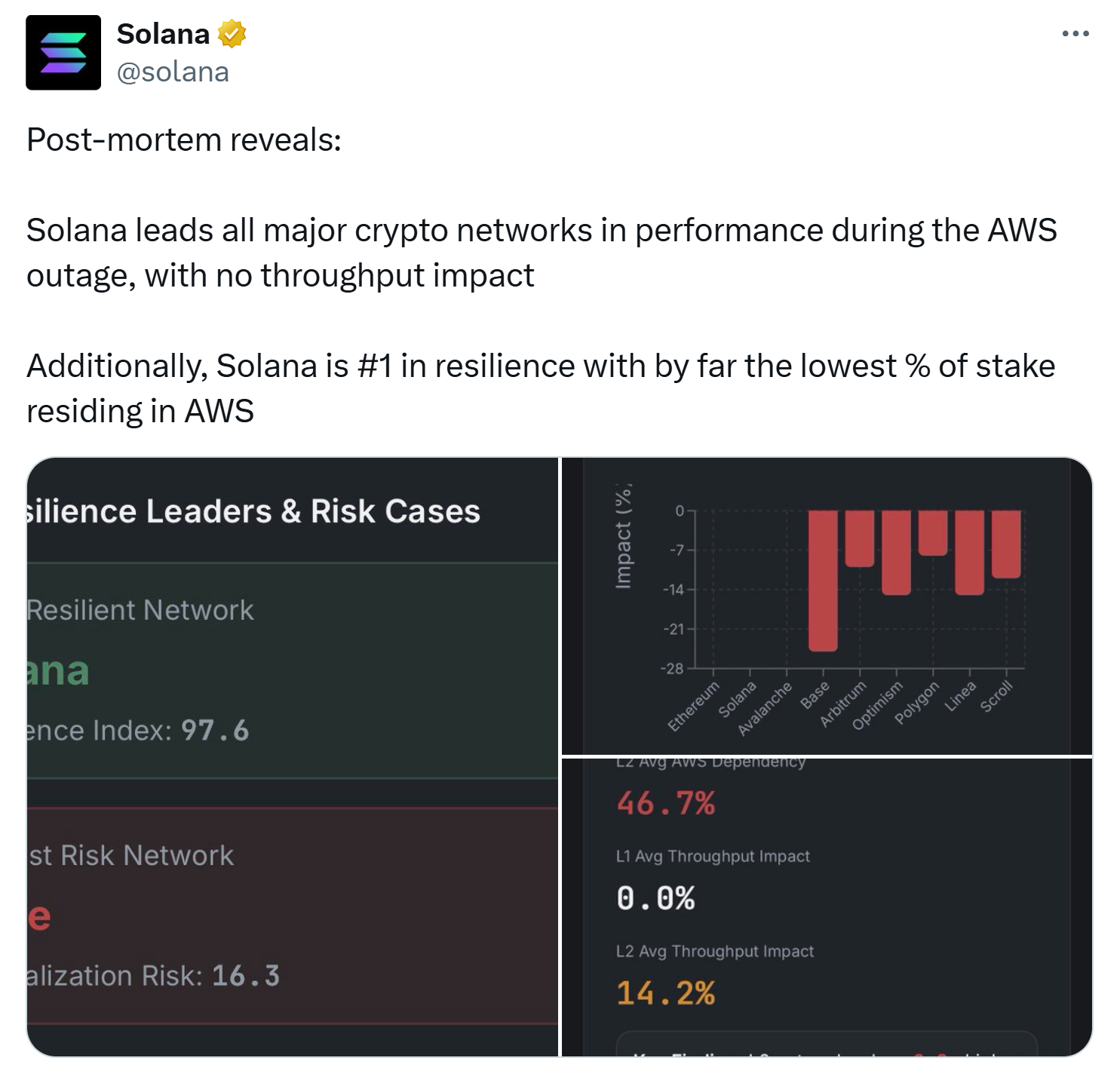The Amazon Web Services (AWS) outage lasting 15 hours disrupted access to key crypto platforms like Coinbase, Robinhood, and MetaMask, highlighting the reliance of Web3 on centralized infrastructure despite blockchain resilience.
-
AWS outage exposed vulnerabilities in crypto interfaces hosted on centralized servers.
-
Blockchains operated normally, but users faced wallet and exchange access issues.
-
Experts recommend hybrid models combining cloud and decentralized networks for better uptime, with 70% of Ethereum nodes on major clouds.
AWS outage hits Coinbase, Robinhood, and more: Discover how this 15-hour disruption revealed Web3’s centralization risks and paths to true decentralization. Read expert insights now.
What is the AWS Outage and How Does It Impact Crypto Platforms?
The AWS outage refers to a 15-hour disruption in Amazon Web Services that affected multiple fintech and crypto services, including Coinbase, Robinhood, and MetaMask. While underlying blockchains like Ethereum and Solana continued to function without interruption, user-facing applications relying on AWS-hosted APIs and interfaces experienced widespread downtime, preventing logins, transactions, and balance checks. This event underscores the gap between blockchain decentralization and the centralized infrastructure supporting Web3 applications.
Why Do Centralized Clouds Still Dominate Web3 Infrastructure?
Centralized cloud providers like AWS, Google Cloud, and Azure dominate Web3 infrastructure due to their proven scalability, compliance features, and high uptime guarantees, which are essential for handling the demands of global user bases. According to industry estimates, approximately 70% of Ethereum nodes are hosted on these major hyperscalers, creating a concentrated risk where a single outage can cascade across numerous platforms. Jamie Elkaleh, chief marketing officer at Bitget Wallet, emphasized in a statement to Cointelegraph that “decentralization has succeeded at the ledger layer but not yet at the infrastructure layer,” pointing out that real resilience requires diversifying beyond these giants into community-driven networks. He noted that while full decentralization at scale remains challenging due to speed and compliance needs, hybrid approaches—distributing workloads across traditional clouds and decentralized alternatives—offer a practical solution to mitigate single points of failure. This outage, which began on a Monday and persisted for about 15 hours, directly impacted Coinbase’s mobile app and Base network, leading to login failures and transaction halts, while Robinhood users encountered API delays. MetaMask users, for instance, saw erroneous zero balances in their wallets, though assets remained secure on the blockchain itself. Anthurine Xiang, co-founder of EthStorage and QuarkChain, described the situation as “the house is fine, but the door is jammed,” illustrating how users were effectively locked out of operational blockchains due to frontend dependencies. Jawad Ashraf, CEO of Vanar Blockchain, further critiqued the industry for “running on the same servers,” likening it to paying multiple landlords rather than achieving true independence. Building fully decentralized systems is feasible but often sidelined for the simplicity of cloud deployment, despite the evident risks exposed by such events.

X user poking fun at so-called decentralized platforms. Source: Kunal Gandhi
The disruption extended beyond crypto to broader fintech, affecting services like Venmo, and served as a stark reminder of infrastructure vulnerabilities. Despite these challenges, platforms like Solana reported no throughput impact, demonstrating that core blockchain operations can remain robust even when auxiliary services falter.

Solana claims no throughput impact from the outage. Source: Solana
In the aftermath, discussions intensified around accelerating the adoption of decentralized alternatives. Elkaleh advocated for investments in networks like Akash for compute, Filecoin for storage, and Arweave for permanent data solutions, arguing that every major outage acts as a catalyst for progress. “The future of Web3 won’t be defined by how decentralized the tokens are, but by how distributed the infrastructure truly becomes,” he stated. Xiang echoed this by stressing the need to redesign every layer—from storage to user access—to eliminate single-provider dependencies, ensuring that no entity can unilaterally offline critical systems. Ashraf highlighted the practical barriers, noting that while decentralized options exist, their complexity and slower performance deter widespread adoption in the short term. This event has prompted calls for “credible multi-homing,” where projects spread operations across multiple providers, including decentralized ones, to enhance redundancy without sacrificing efficiency.
From a broader perspective, the AWS outage illustrates the evolving nature of Web3. Blockchains have achieved remarkable decentralization at the protocol level, with distributed ledgers processing transactions globally without central oversight. However, the ecosystem’s user interfaces, APIs, and supporting services often lean on established cloud infrastructure for reasons of reliability and cost-effectiveness. This hybrid reality enables rapid innovation but introduces systemic risks, as evidenced by the millions of users temporarily sidelined from their digital assets. Regulatory compliance also plays a role; many crypto firms utilize AWS for its robust data sovereignty features and adherence to standards like SOC 2, which decentralized networks are still maturing to match.
Looking at historical precedents, similar outages have occurred, such as previous AWS incidents affecting gaming and e-commerce, but the crypto sector’s sensitivity to uptime amplifies the fallout. During this event, trading volumes on affected exchanges dipped temporarily, though on-chain activities on resilient networks like Solana proceeded unaffected. This dichotomy reinforces the importance of layered decentralization: securing the base layer while progressively decentralizing the application layer.
Frequently Asked Questions
What caused the AWS outage that affected Coinbase and other crypto platforms?
The AWS outage stemmed from a regional disruption in Amazon Web Services’ infrastructure, lasting about 15 hours and impacting services hosted in specific zones. It halted APIs and interfaces for platforms like Coinbase, preventing user access despite blockchains operating normally, as reported by AWS status updates and affected companies.
How can Web3 projects reduce reliance on centralized clouds like AWS?
Web3 projects can reduce reliance on centralized clouds by adopting hybrid infrastructure models that integrate traditional providers with decentralized networks for storage, compute, and node hosting. This approach distributes workloads to avoid single points of failure, improving resilience as voice search queries on decentralization strategies increasingly highlight expert recommendations for multi-homing solutions.
Key Takeaways
- Centralization Risks Exposed: The outage showed that while blockchains are decentralized, user interfaces on AWS create vulnerabilities affecting millions.
- Hybrid Models Recommended: Experts like Jamie Elkaleh suggest combining cloud scalability with decentralized networks for balanced resilience.
- Path to True Decentralization: Invest in alternatives like Filecoin and Akash to build distributed infrastructure and prepare for future disruptions.
Conclusion
The AWS outage that disrupted Coinbase, Robinhood, MetaMask, and other crypto platforms serves as a pivotal moment, revealing the ongoing tension between Web3’s decentralized promise and its centralized infrastructure dependencies. As emphasized by leaders like Anthurine Xiang and Jawad Ashraf, advancing toward fully distributed systems through hybrid strategies will be crucial for long-term stability. Moving forward, the industry must prioritize diversification to ensure that innovations in blockchain technology translate into reliable user experiences, fostering greater trust and adoption in the evolving digital economy.





